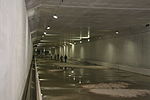Allied bombings of Amsterdam-Noord

The Allied bombings of Amsterdam-Noord took place in July 1943 during the Nazi-occupation of the Netherlands in World War II. Three strategic bombing attacks by Allied Forces were aimed at the former Fokker Aircraft Factory in the northern part of Amsterdam, which was of interest as the factory was confiscated by the Nazis and employees were forced to produce aircraft for the Luftwaffe. However, only 7 out of the 326 bombs from these three airstrikes hit their target, while the others fell on the surrounding residential area, resulting in the loss of more than 206 lives in total. The attacks were the most damaging and deadly bombardment of Amsterdam during the Second World War, and the most disastrous airstrike the city has ever endured. As these were Allied attacks, the losses and trauma caused by the event have always been a sensitive and painful topic for the citizens of Amsterdam-Noord.
Excerpt from the Wikipedia article Allied bombings of Amsterdam-Noord (License: CC BY-SA 3.0, Authors, Images).Allied bombings of Amsterdam-Noord
Papaverweg, Amsterdam Noord
Geographical coordinates (GPS) Address Nearby Places Show on map
Geographical coordinates (GPS)
| Latitude | Longitude |
|---|---|
| N 52.395833333333 ° | E 4.9083333333333 ° |
Address
Papaverweg 34
1032 KJ Amsterdam, Noord
North Holland, Netherlands
Open on Google Maps








